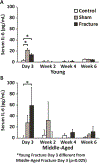Systemic Bone Loss After Fracture
- PMID: 31363348
- PMCID: PMC6667184
- DOI: 10.1007/s12018-018-9253-0
Systemic Bone Loss After Fracture
Abstract
A history of prior fracture is the most reliable indicator of prospective fracture risk. Increased fracture risk is not confined to the region of the prior fracture, but is operant at all skeletal sites, providing strong evidence of systemic bone loss after fracture. Animal and human studies suggest that systemic bone loss begins shortly after fracture and persists for several years in humans. In fact, bone quantity and bone quality may never fully return to their pre-fracture levels, especially in older subjects, demonstrating a need for improved understanding of the mechanisms leading to systemic bone loss after fracture in order to reduce subsequent fracture risk. Although the process remains incompletely understood, mechanical unloading (disuse), systemic inflammation, and hormones that control calcium homeostasis may all contribute to systemic bone loss. Additionally, individual factors can potentially affect the magnitude and time course of systemic bone loss and recovery. The magnitude of systemic bone loss correlates positively with injury severity and age. Men may also experience greater bone loss or less recovery than women after fracture. This review details the current understanding of systemic bone loss following fracture, including possible underlying mechanisms and individual factors that may affect this injury response.
Keywords: Bone Loss; Fracture Risk; Fracture healing; Osteoporosis.
Figures







Similar articles
-
Incident fracture is associated with a period of accelerated loss of hip BMD: the Study of Osteoporotic Fractures.Osteoporos Int. 2018 Oct;29(10):2201-2209. doi: 10.1007/s00198-018-4606-6. Epub 2018 Jul 10. Osteoporos Int. 2018. PMID: 29992510 Free PMC article.
-
Age Dependence of Systemic Bone Loss and Recovery Following Femur Fracture in Mice.J Bone Miner Res. 2019 Jan;34(1):157-170. doi: 10.1002/jbmr.3579. Epub 2018 Sep 24. J Bone Miner Res. 2019. PMID: 30189111 Free PMC article.
-
Previous exposure to simulated microgravity does not exacerbate bone loss during subsequent exposure in the proximal tibia of adult rats.Bone. 2013 Oct;56(2):461-73. doi: 10.1016/j.bone.2013.07.004. Epub 2013 Jul 17. Bone. 2013. PMID: 23871849
-
Skeletal adaptations to alterations in weight-bearing activity: a comparison of models of disuse osteoporosis.Sports Med. 2002;32(7):459-76. doi: 10.2165/00007256-200232070-00005. Sports Med. 2002. PMID: 12015807 Review.
-
Bone loss, contraception and lactation.Acta Obstet Gynecol Scand. 1993 Apr;72(3):148-56. doi: 10.3109/00016349309013363. Acta Obstet Gynecol Scand. 1993. PMID: 8385847 Review.
Cited by
-
Estrogen and estrogen receptors mediate the mechanobiology of bone disease and repair.Bone. 2024 Nov;188:117220. doi: 10.1016/j.bone.2024.117220. Epub 2024 Aug 5. Bone. 2024. PMID: 39106937 Review.
-
Progress in Prevention and Treatment of Acute Bone Loss in Orthopedics.Int J Endocrinol. 2023 Nov 30;2023:9373043. doi: 10.1155/2023/9373043. eCollection 2023. Int J Endocrinol. 2023. PMID: 38077930 Free PMC article. Review.
-
Sticky Bone as a New Type of Autologous Bone Grafting in Schatzker Type II Tibial Plateau Fracture Case Report.Life (Basel). 2024 Aug 21;14(8):1042. doi: 10.3390/life14081042. Life (Basel). 2024. PMID: 39202784 Free PMC article.
-
Pathophysiological mechanism of acute bone loss after fracture.J Adv Res. 2023 Jul;49:63-80. doi: 10.1016/j.jare.2022.08.019. Epub 2022 Sep 15. J Adv Res. 2023. PMID: 36115662 Free PMC article. Review.
-
Age-Dependent Changes in Bone Architecture, Patterning, and Biomechanics During Skeletal Regeneration.Front Cell Dev Biol. 2021 Oct 13;9:749055. doi: 10.3389/fcell.2021.749055. eCollection 2021. Front Cell Dev Biol. 2021. PMID: 34722531 Free PMC article.
References
-
- Learn What Osteoporosis Is and What It’s Caused by [Internet]. Natl. Osteoporos. Found. [cited 2018 Jul 27]. Available from: https://www.nof.org/patients/what-is-osteoporosis/
-
- Johnell O, Kanis JA, Odén A, Sernbo I, Redlund-Johnell I, Petterson C, et al. Fracture risk following an osteoporotic fracture. Osteoporos Int. 2004;15:175–9. - PubMed
-
- Ahmed LA, Center JR, Bjørnerem Å, Bluic D, Joakimsen RM, Jørgensen L, et al. Progressively increasing fracture risk with advancing age after initial incident fragility fracture: the Tromsø study. J Bone Miner Res. 2013;28:2214–21. - PubMed
